Commonwealth of Dominica
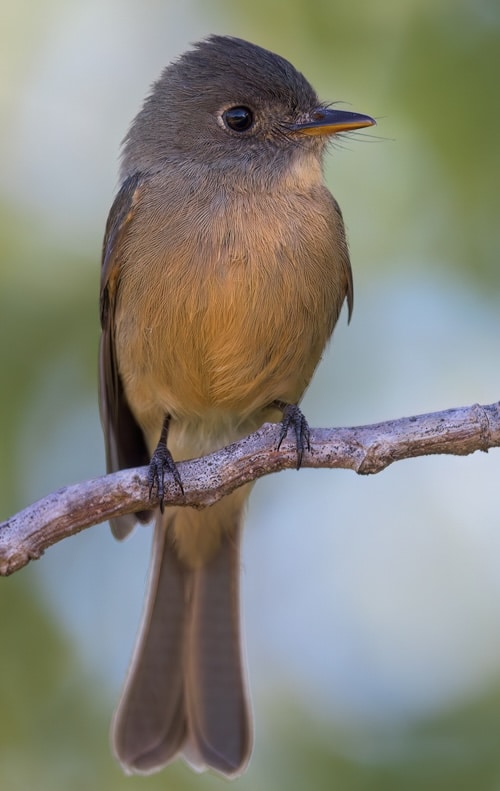
Dominica (pronounced Domineeca and not to be confused with the Dominican Republic) is an island country in the Caribbean. It is part of the Windward Islands chain in the Lesser Antilles archipelago in the Caribbean Sea. The capital, Roseau, is located on the western side of the island. Dominica’s closest neighbours are two constituent territories of the European Union, both overseas departments of France: Guadeloupe to the northwest and Martinique to the south-southeast. Dominica comprises a land area of 750 km2 (290 square miles), and the highest point is Morne Diablotins at 4,747 feet. The population is about 66,000 people, around 20% of whom live in the capital.
Dominica has been nicknamed the ‘Nature Island of the Caribbean’ for its natural environment. It is the youngest island in the Lesser Antilles, and is still being formed by geothermal-volcanic activity, as evidenced by the world’s second-largest hot spring, called Boiling Lake. The island has lush mountainous rainforests and is the home of many rare plants, animals, and bird species. There are dry shrubland areas in some of the western coastal regions, but heavy rainfall occurs inland.
Within its borders lie two eco-regions: Windward Islands moist forests and Windward Islands xeric scrub. The most mountainous of the Lesser Antilles, its volcanic peaks are cones of lava craters. The Calibishie area in the country’s northeast has sandy beaches. Some plants and animals thought to be extinct on surrounding islands can still be found in Dominica’s forests. The island has several protected areas, including Cabrits National Park and Morne Trois Pitons National Park is a tropical forest blended with volcanic features; it is a World Heritage Site, as well as 365 rivers.
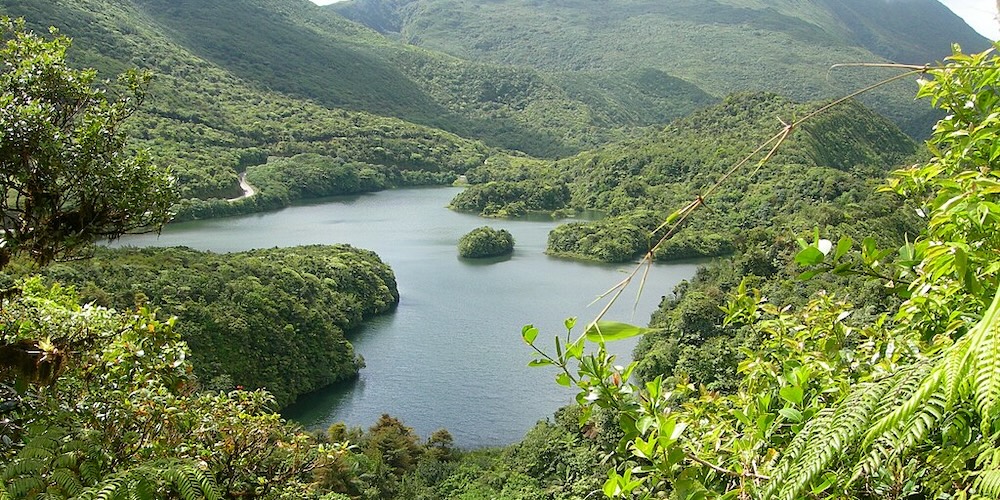
Boeri Lake, Morne Trois Pitons National Park – ©Charlottea via Wikimedia Commons
Dominica has recorded four species of (non-venomous) snakes and eleven species of lizards. Dominica is the last major stronghold of the critically endangered Lesser Antillean iguana.
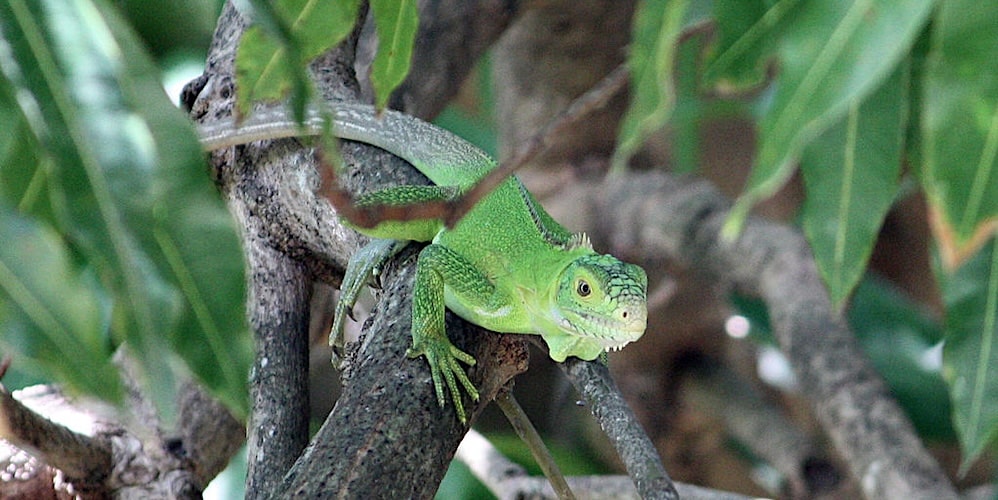
Lesser Antillean Iguana Iguana delicatissima – ©Postdlf CC BY-SA 3.0 via Wikimedia Commons
The Caribbean Sea around the island of Dominica is home to many cetaceans. A group of sperm whales live in the area year-round. Other cetaceans commonly seen in the area include spinner dolphins, pantropical spotted dolphins and bottlenose dolphins. Less commonly seen animals include killer whales, false killer whales, pygmy sperm whales, dwarf sperm whales, Risso’s dolphins, common dolphins, Atlantic spotted dolphins, humpback whales and Bryde’s whales. This makes Dominica a destination for tourists interested in whale-watching.
Birding Dominica
The Sisserou Parrot, also known as the imperial amazon, is critically endangered and found only on Dominica. It is the island’s national bird and is featured on the national flag, making Dominica.
Luscious vegetation and inherent forest blanket the island’s towering territory, while the 365 rivers and streams meander their way through ravines and gorges to gush over many waterfalls, producing the island’s cooling system and allowing many opportunities to take an exhilarating dip in clear clean waters. Tree ferns, orchids, heliconia and anthurium lilies embellish the forest floor while 175 species of birds, green iguanas, geckoes, tree lizards, agouti, manicou, magnificent butterflies and a vast array of picturesque flora can be enjoyed throughout an island where nature trails are abundant.
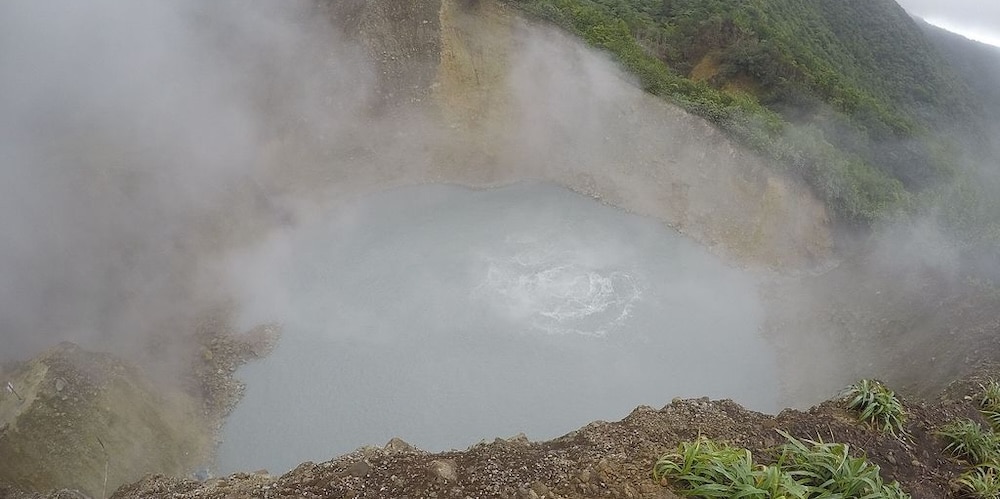
Boiling Lake – ©Bayukjdr via Wikimedia Commons
Many of the locals farm bananas, citrus and other tropical fruit on the beautiful mountain banks. Crime is scarce and should not discourage one’s sense of freedom and absolute enjoyment. There are no large resorts in Dominica. The largest hotel has only 53 rooms, and is located in the capital.
Dominica is a very exciting place for the bird watcher not only because for its size and position it has a comparatively rich avifauna, but also because it is a place where anything can turn up, much of the island being explored by very few ornithologists. Within an area of less than 800 square kilometres lies a rich variety of habitat – from cloud forest and Montane thicket through tall strands of rain forest to drier scrubbier woodland, and interspersed amongst these are lakes, rock canyons, rivers and water falls, plantations and gardens. The perimeter of the island has stunning sea cliffs between secluded coves and sandy beaches, estuaries, as well as some marshes and swamps. There are few places in the world where one can be clambering in the clouds over an elfin woodland canopy watching Blue-headed Hummingbirds and Plumbeous Warblers, then, an hour after, be deep within rain forest amongst Imperial and Red-necked Parrots, and an hour after that down at sea level watching ducks, herons, and egrets on the edge of a densely vegetated swamp, or Frigatebirds, boobies and terns over the Caribbean Sea.
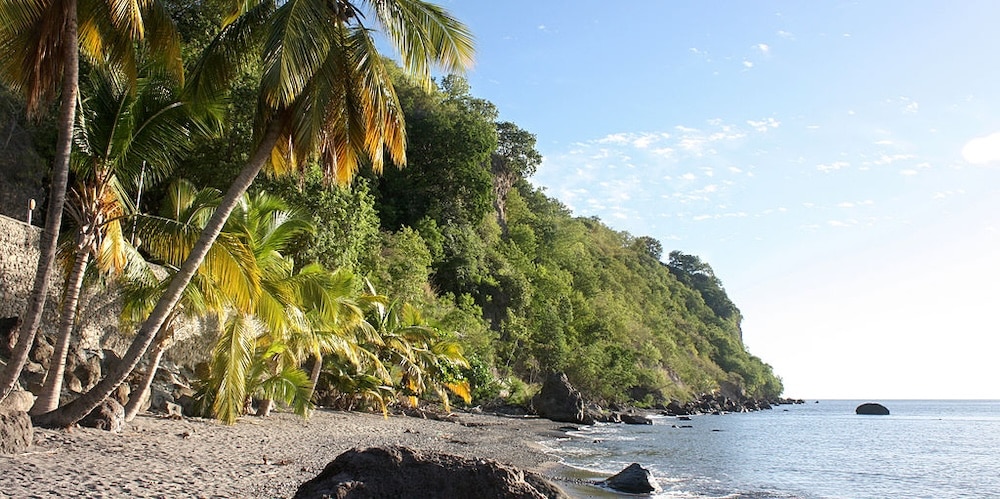
Batalie Beach – ©Postdlf CC BY-SA 3.0 via Wikimedia Commons
It is perfectly possible to see all the species of island and Lesser Antillean regional endemics which occur in Dominica within a single day, although much more satisfaction will come from spreading this over a longer period, mixing those sightings with observations of other typical avian representatives of the different habitats. During every month of the year, there will be at least some birds visiting Dominica on migration, so one can never predict what unusual species might be seen. The number of known bird species to be seen in Dominica during the various seasons of the year totals almost 200, including 4 types of native hummingbird. Whether it is the Blue-hooded Euphonia, Mountain Whistler, Broad-winged Hawk or the two native parrot species you wish to see, local guides know just where to find them. There are a great many choices of prime locations throughout the island, but one top spot is mentioned below.
-
Morne Diablotin National Park
InfgormationSatellite ViewSisserou and Jacquot parrots (found only in Dominica) are most commonly sighted in the Syndicate Forest area on the western slopes of the Morne Diablotin National Park. Nearby Milton Falls on the Dublanc River is a perfect picnic spot where you may take a refreshing bath.
-
Number of bird species: 199
(As at March 2025)National Bird: Imperial Amazon (Sisserou) Amazona imperialis
Number of endemics: 3
Red-necked ParrotAmazona arausiaca
Imperial Parrot Amazona imperialis
Kalinago Wren Troglodytes martinicensis
-
Avibase
PDF ChecklistThis checklist includes all bird species found in Dominica , based on the best information available at this time. It is based on a wide variety of sources that I collated over many years. I am pleased to offer these checklists as a service to birdwatchers. If you find any error, please do not hesitate to report them. -
Bird ID
Annotated ListList of Birds of Dominica -
E-Bird
PDF ChecklistThis checklist is generated with data from eBird (ebird.org), a global database of bird sightings from birders like you. If you enjoy this checklist, please consider contributing your sightings to eBird. It is 100% free to take part, and your observations will help support birders, researchers, and conservationists worldwide. -
Wikipedia
Annotated ListThe avifauna of Dominica, a Caribbean island nation, included a total of 198 species according to Bird Checklists of the World as of October 2024.[1] Of them, two are endemic, six have been introduced by humans, and 121 are rare or accidental. One species has been extirpated.
-
Dominica's Birds
| By Arlington James, Stephen Durand and Bertr& Jno Baptiste | FWPD | 2005 | Paperback | 135 pages, drawings, photos, map | Out of Print | ISBN: Buy this book from NHBS.com -
The Birds of the West Indies
| By Guy M Kirwan, Anthony Levesque, Mark W Oberle & Christopher J Sharpe | Lynx Edicions | 2019 | 400 pages, 1600+ colour illustrations, 650+ colour distribution maps | ISBN: 9788416728176 Buy this book from NHBS.com

Birds of the West Indies
AndroidThis bilingual, mobile field guide for the West Indies includes all 415 bird species of Puerto Rico and the northeastern Lesser Antilles: Virgin Islands, Anguilla, Saint Martin (Sint Maarten), Antigua and Barbuda, Montserrat, Sint Eustatius, Saint Kitts and Nevis, Saint Barthélemy (St. Barts), and Saba.
Birds of the West Indies
Apple iOS |Explore the vibrant Caribbean islands with Birds of the West Indies – your pocket guide to Caribbean birdwatching!Useful Information-
Discover Dominica
InformationThe perfect haven for birds is the perfect place for birders.
Organisations-
Rare Species Conservatory Foundation
WebsiteOverseas conservation projects focus on several species of critically endangered Caribbean parrots including the Imperial and red-neck Amazon parrots of Dominica and the St. Vincent Amazon parrot from St. Vincent… -
WildDominique
WebsiteWildDominique is a non-profit conservation organisation registered in the Commonwealth of Dominica. Dominican life, culture, and economy revolves around nature.
Reserves-
*Protected Areas of Dominica
InformationSatellite ViewInteractive lists of reserves and parks -
NP Cabrits
InformationSatellite ViewCabrits National Park is located on the northwestern coast of Dominica, an area of 1,313 acres of upland and 1,053 acres of marine or underwater park… -
NP Morne Diablotin
InformationSatellite ViewThe park is home to 1,447-meter high Morne Diablotin, the tallest mountain on the island and the second highest mountain in the Lesser Antilles. It was established in January 2000, primarily to protect the habitat of the endangered sisserou parrot, an endemic bird species that is a national symbol of Dominica. -
NP Morne Trois Pitons
InformationSatellite ViewThe National Park is named after its highest mountain, Morne Trois Pitons, meaning mountain of three peaks. The park is a significant area of volcanic activity. Features within the part include the Valley of Desolation, a region of boiling mud ponds and small geysers; the Boiling Lake, Titou Gorge, and Emerald Pool.
Sightings, News & Forums-
eBird
SightingseBirding This Year
Guides & Tour Operators-
Beija Flor
Tour OperatorLet’s chase waterfalls while birding in Dominica where we will traverse lush landscapes in search of the Nature Island’s endemic bird species. -
Birding the Islands
Tour OperatorEvery Endemic in the Lesser Antilles -
Dr Birdy
Local Tour OperatorTake a tour with Dr Birdy, Dominica’s birding expert and learn all about the variety of birds we have here. -
Eagle-Eye Tours
Tour OperatorBest of the Lesser Antilles -
Naturalist Journeys
Tour OperatorStretching from north to south between the Atlantic Ocean and the Caribbean Sea, lies an arc of tropical island gems ringed by turquoise seas and sandy beaches. -
NatureTrek
Tour OperatorThe Lesser Antilles - Exploring St. Lucia, St. Vincent and Dominica -
Shore Excursions
Local Tour OperatorThe island of Dominica is full of many ideal and natural outdoor attractions, making for a perfect place to discover bird watching. -
Sunrise Birding
Tour OperatorAntigua, Barbados, Barbuda, Dominica, Grenada, Guadeloupe, Martinique, Montserrat, St. Lucia and St. Vincent -
Tours By Locals - Danny E
Local Tour OperatorIf you have a passion for Bird watching and Nature walks then this tour is for you! Let us discover what's at the foot of Dominica's highest mountain , located on the northern side of the Island. -
WINGS
Tour OperatorThese 10 stunningly beautiful Caribbean islands form the eastern border between the placid Caribbean Sea and the mighty Atlantic Ocean. -
Wild Latitudes
Tour OperatorThis tour has been designed for both birders and general nature enthusiasts
Trip Reports-
2016 [04 April] - Jesse Fagan - Lesser Antilles
Report10 islands, 14 days, 14 flights, 8 hotels, 1 visit to the emergency room, drive on the right, drive on the left,...you get the picture. It requires a lot of action and movement to see these birds! And see them we did. It was another successful island-hopping adventure this year, and the logistics worked out fine on this logistically complicated tour. Even island time seemed faster. -
2019 [02 February] - Lars Olausson
PDF Report...The birding overall was very slow along the Syndicate trail, we did just see a few of the Dominican race of House Wren and one brief encounter with Plumbeous Warbler, and a few observations of hummingbirds... -
2020 [03 March] - David Ascanio
PDF Report...Some groups got to see a pair in flight, others just got to hear other pairs. Also, everyone enjoyed great views of the Red-necked Parrot (another endemic species) and superb views of a Mangrove Cuckoo. Some participants found a male and a female Blue-headed Hummingbird, another target species and the third endemic of the island... -
2022 [11 November] - Richard Baines
ReportA Caribbean Birding Adventure Part II - Dominica -
2023 [03 March] - Ian Merrill
PDF Report...A little research soon revealed however that a well-planned visit of suitable duration, to St Lucia and Dominica, could potentially provide two-thirds of the island chain’s available endemic bird species... -
2023 [06 June] - David Hollie
PDF Report...It was the heat of the day and I needed to refill my water, so I didn’t stay long. Red-legged Thrush and Plumbeous Warbler were the two highlights of my short walk here... -
2023 [12 December] - Chris Harbard - Lesser Antilles
PDF ReportThe group of six participants, plus guides Chris and Ryan, arrived on different flights in to St Lucia airport, but all gathered for dinner at Balenbouche Estate to begin our fabulous three-island trip. We were to visit St Lucia, Dominica and St Vincent with a short stop on the bonus island of Barbados... -
2024 [03 March] - Peg Abbott - Lesser Antilles
PDF ReportA grand adventure designed to showcase the endemic species of 10 Lesser Antillean Islands in 14 days - we met the challenge of multiple flights and ferries and as a group were successful in finding them all! O -
2024 [04 April] - Jesse Fagan - Lesser Antilles
PDF ReportNot surprising, for a logistically complicated trip like this tour (10 islands in 15 days!)...
Places to Stay-
3 Rivers Eco Lodge
AccommodationWelcome to 3 Rivers and Rosalie Forest Eco Lodge, Dominica -
Picard Beach Cottages
AccommodationSituated on a golden sand beach, in a garden of flowering tropical shrubs on the north-east coast of Dominica, at the foot of the island`s highest mountain, Morne Diablotin - preserve of the endangered indigenous Sisserou parrot; One mile south of the city of Portsmouth; 20 miles along the north coast from Melville Hall Airport; 25 miles along the west coast from Canefield Airport. -
ort Young Hotel
AccommodationAccompany the island’s leading birders and ornithologists for an insider’s look at Dominica’s vibrant avian paradise
Fatbirder - linking birders worldwide...
Skip to content
